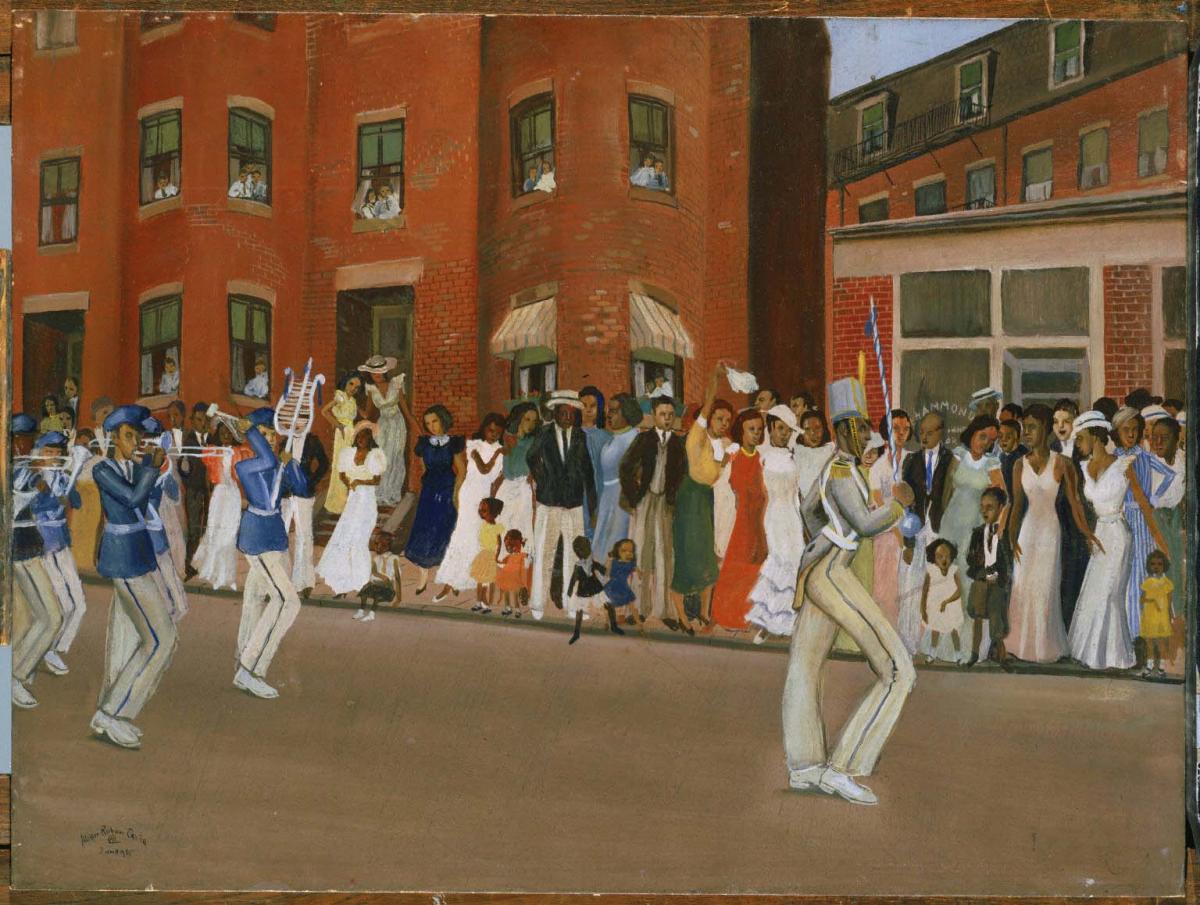Parade on Hammond Street
Allan Rohan Crite ( 1935 )

Parade on Hammond Street was one of two dozen paintings in Allan Rohan Crite’s Neighborhood Series, completed in the 1930s. Crite is called “the neighborhood reporter” for his romantic, realistic depictions of the South End and Lower Roxbury neighborhoods of Boston. The distinct architecture in Crite’s pieces orients the viewer in Boston’s Black community. At the time Parade on Hammond Street was painted, Crite was attending the School of the Museum of Fine Arts, under the direction of Philip Hale, a member of the Boston School of Painters. The influence of the Boston School on Crite’s style is evident through his use of one-point perspective to create the background, his treatment of figures, and his attention to detail. Crite’s objective was to change how Black Americans were perceived. He stated his frustration, explaining: “I was making studies of black people just as ordinary human beings, because the usual picture that one had … was that the artist was strongly influenced by, you might say, the jazz person up in Harlem, or the sharecropper in the deep South. There was nothing in between—of just the ordinary middle-class person who goes to church, does the work, etc.”[1] Instead, Crite set out to represent his community through his point of view: as active members of society.
The parade represented was an annual event organized by the Elks, a fraternal order, in Lower Roxbury. The onlookers line the sidewalk and perch in windows to watch the marching band. The women wear modest, floor-length dresses and Sunday hats to convey their moral virtue, and the uniforms worn by the band indicate order. Crite uses his understanding of color to further his ideologies. The crowd’s brightly colored clothing allows them to stand out against the brick-red buildings. The color blue, worn by the members of the band as well as many members of the crowd, is associated with competence, intelligence, and trust.[2] Crite’s aim through his work was to elevate his surroundings and his community through representation. He credited Pieter Bruegel, a 16th-century Flemish painter known for his scenes of peasant life, as a significant source of inspiration for his art.[3]
Text by Rebecca Shipman as part of the Seeing U.S. Research Project
[1] Alan Rohan Crite, oral history interview transcript, January 16, 1979–October 22, 1980. Smithsonian Archives of American Art.
[2] Lauren I. Labrecque and George R. Milne, “Exciting Red and Competent Blue: The Importance of Color in Marketing,” Journal of the Academy of Marketing Science 40 (2012): 711–27.
[3] Edward Clark, Annamae Palmer Crite, and Allan Rohan Crite, “Annamae Palmer Crite and Allan Rohan Crite: An Interview with Mother and Artist Son,” MELUS 6, no. 4 (Winter 1979): 70.
Parade on Hammond Street, executed from memory in June 1935, was inspired by a parade the artist witnessed near his residence in the Roxbury neighborhood of Boston. Painted in predominantly warm, vibrant colors, this urban genre scene focuses on the neighborhood's extensive African-American community, with residents dressed in their best attire gathered to watch a festive, locally organized parade before Sunday church services. It is characteristic of Crite’s early work in its documentary emphasis, fine detail, and celebratory tone. Crite painstakingly reconstructed the settings of his works to ground them in reality and make the images accessible to the viewer. The neighborhood shown here has been dramatically altered by urban renewal, so his meticulous rendition of the brick buildings documents the place as well as the event.
Even though he was aware of modernism, Crite chose to use a representational style because it was more natural to him. Crite once said, “I'm a storyteller, telling a story of people,” he claimed, “and I started out with my own people in the immediate sense, like the neighborhood, and people in a general sense when I make a neighborhood out of the whole world.”